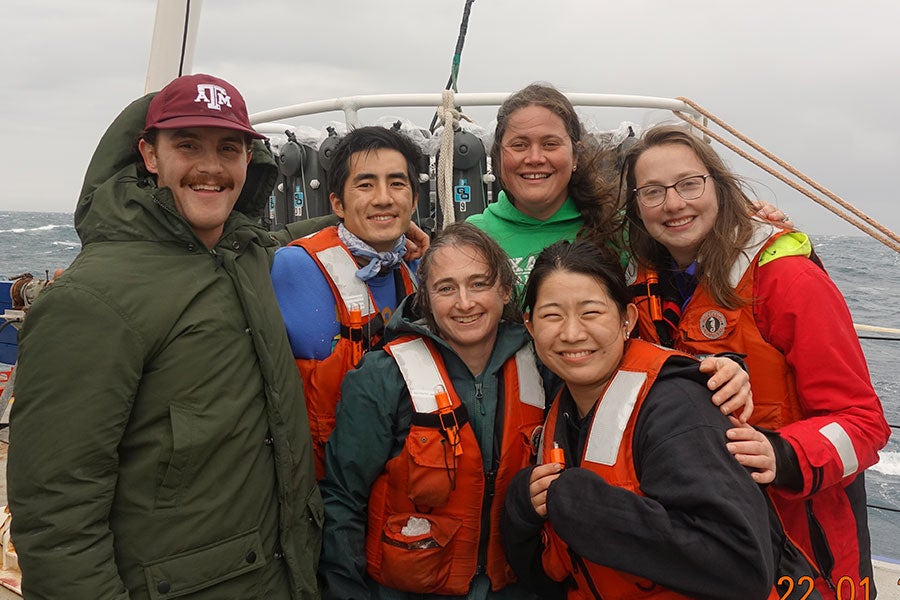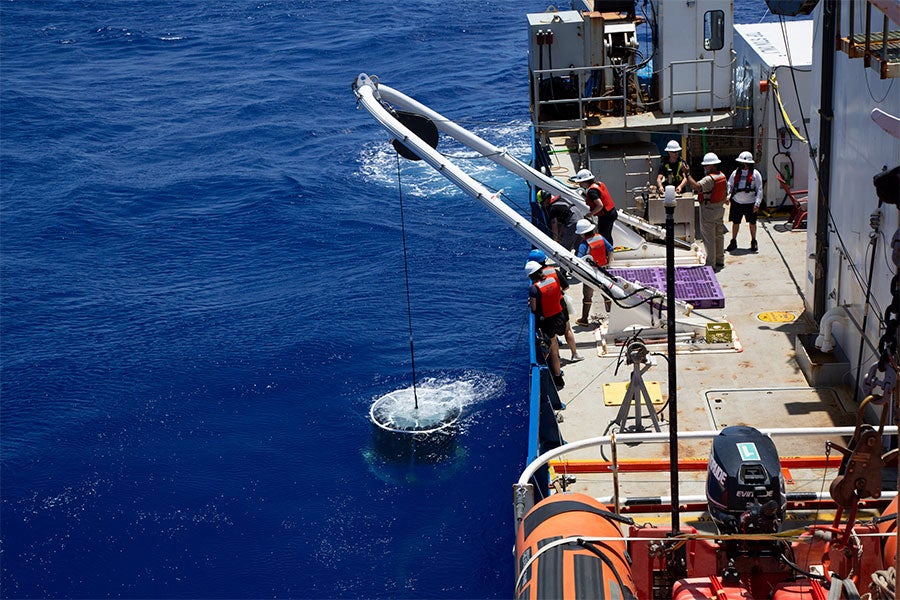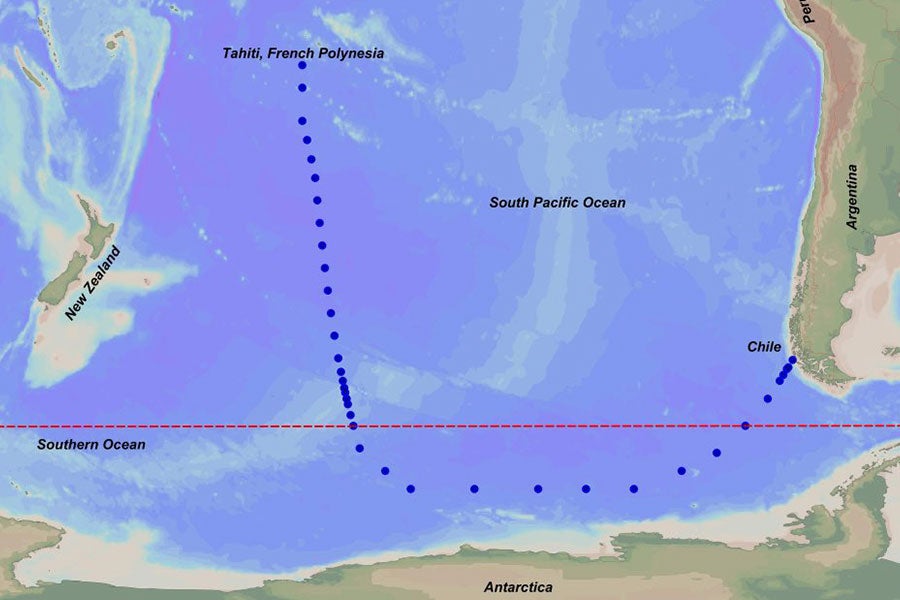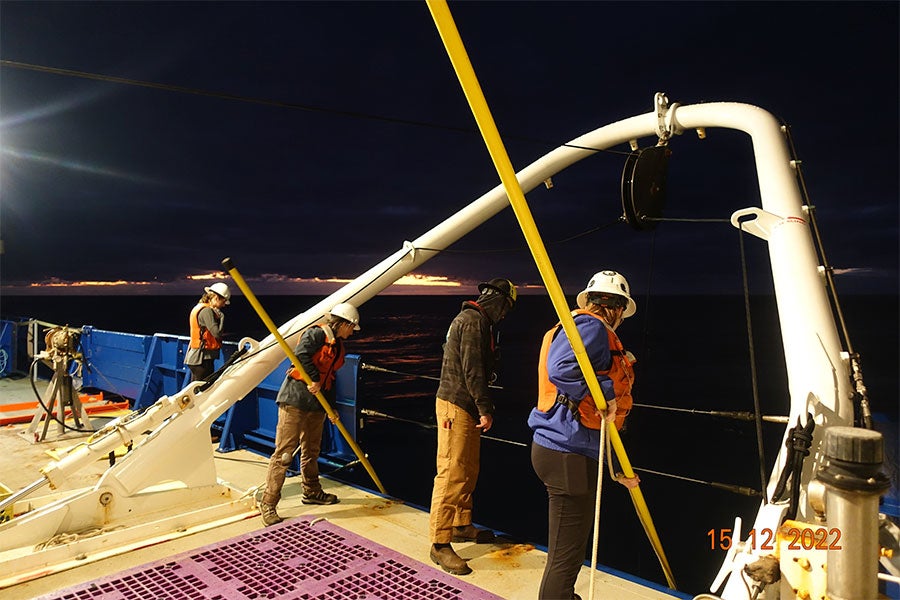Research at the End of the Earth
Last winter, Emily Frett ’22 got the opportunity of a lifetime when she joined a two-month research cruise to the Antarctic, an area few researchers ever get to visit. A grad student in the Department of Ocean and Earth Sciences at Old Dominion University in Norfolk, Va., Frett researches dissolved organic sulfur (DOS) in the ocean. DOS is an important but understudied element for helping build a better picture of marine and climate processes.
Frett’s trip was led by GEOTRACES, an international effort to track trace elements in the ocean in response to changing environmental conditions. It was the perfect opportunity for Frett to take her science out of the lab and into the field—but it didn’t come without risk.

Frett (far right) and her cohort stand in front of the instrument they deployed to collect water samples.
Conducting science in big waves
The waves in Antarctica are legendary. Because there are no landmasses to break up the wind, waves that far south build quickly and intensely, giving rise to nicknames based on southern latitude: the Roaring 40s, Furious 50s, and Screaming 60s.
Frett says that the waves were indeed a battle. Some of her cruisemates were seasick for a month. Luckily, she has a tough stomach, but sample collection was tricky. As a super tech whose role was to collect and preserve samples, Frett says, “There was a lot of balancing safety with this drive for science, and then trying to figure out where the boundary is—how far are we going to push it?”

Frett’s team collected water samples from the surface of Antarctic waters to as deep as 5,000 meters. After collection, they brought the samples into a lab van, where they pressurized and filtered them before sending them to labs across the country or using them for their own research.
Another challenge was the pace of the science. Frett’s cruise collected samples from 39 sites not only for the researchers on board but also for labs across the country. The breakneck pace meant that sample collection happened around the clock. “We had so much science planned,” Frett says. “We were nonstop. At any given time, we had a bunch of different instruments going. We would drop in our rosette to collect the water samples and as soon as that came up, there was another one going in just a couple feet away. As soon as that was up, we would put something else in. And once all that was done, we’d leave for the next site.”

The dots on the map show the intended sampling stations for Frett’s cruise. One in the Antarctic circle was canceled because of ice cover, which had to remain below 10 percent for the stop to be considered safe.
Building a picture of ocean cycling
Back at the ODU lab, Frett is analyzing her samples to build a profile of how DOS shows up in the water column (the vertical profile of ocean water). “It’s an important element to study because it has to do with trace metal cycling in the ocean—it can bind to different trace metals and help them stay in the water column or let them fall out,” she says.
Now that she’s back on dry ground, the impact of the trip has really hit her. “This is what I really wanted,” she says, “to study the ocean, to travel the world, to look at the different ways geography and geology and chemistry come together.”

Frett (in blue) and her fellow researchers retrieved the sampling instrument from deployment using yellow poles to grab onto the sides of the instrument to stabilize it as they pulled it up.
In her research, Frett primarily uses two instruments: an ion chromatograph and a gas chromatograph. She credits Luther with building her comfort level with them.
“Something that’s really unique about the Luther chemistry program is the amount of instruments we got time on,” she says. “When I was applying to grad schools, I made sure to highlight that. And even now, having had the Instrumental Methods Lab really helped me figure out the instruments that I’ve been using in this work.”